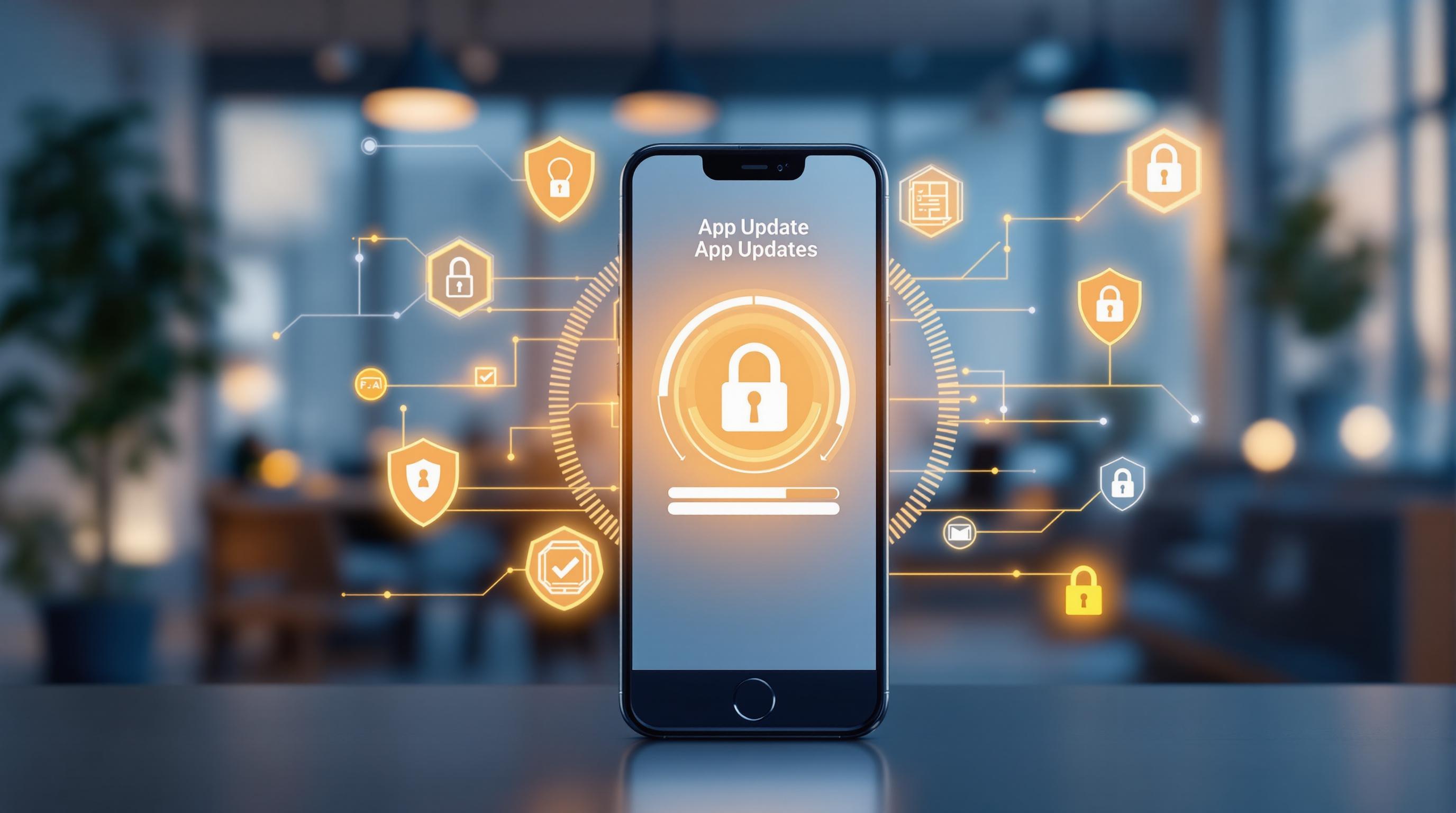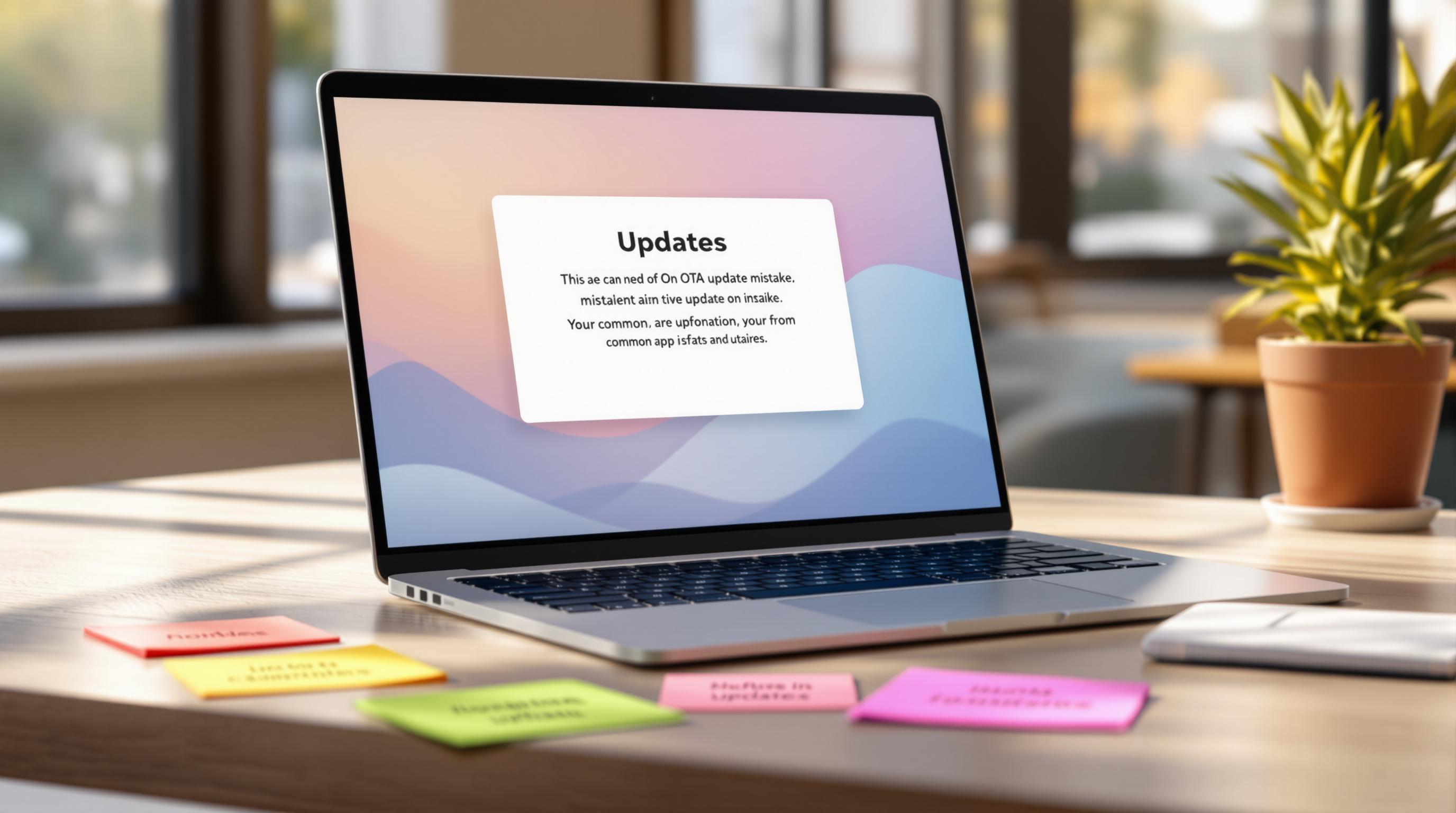Over-the-Air (OTA) encryption ensures secure app updates while meeting the strict rules of Apple and Google app stores. Here’s how it works and why it’s essential:
- Protects Updates: Encryption blocks data interception, tampering, and unauthorized access during update delivery.
- Follows App Store Rules:
- Apple: Requires HTTPS (TLS 1.2+), App Transport Security (ATS), and code signing.
- Google: Enforces SSL pinning, Play Protect scanning, and industry-standard encryption.
- Uses AES-256: A highly secure encryption standard with 256-bit keys for robust data protection.
- End-to-End Security: Updates are encrypted from creation to installation, ensuring integrity and device-specific decryption.
Quick Comparison of App Store Requirements:
| Requirement | Apple App Store | Google Play Store |
|---|---|---|
| Protocol | HTTPS (TLS 1.2+) | HTTPS mandatory |
| Key Storage | iOS Keychain | Android Keystore |
| Code Verification | Mandatory code signing | Play Protect scanning |
| Encryption Standard | AES-256 recommended | Industry-standard encryption |
Unity Encryption Export Compliance | Apple iOS Export Compliance
OTA Update Encryption Methods
Modern OTA update systems use layered encryption techniques to maintain security and comply with app store standards. These methods protect updates throughout their creation, delivery, and installation processes.
TLS Protocol Security
Transport Layer Security (TLS) is the backbone of secure OTA update delivery. It meets important requirements like Apple’s ATS and Google’s SSL pinning by establishing an encrypted connection between servers and devices. This prevents data from being intercepted or tampered with during transmission.
Here’s how TLS features align with security and compliance needs:
| Feature | Security Benefit | Compliance Impact |
|---|---|---|
| Forward Secrecy | Safeguards past communications if keys are compromised | Required by Apple ATS [3] |
| Strong Cipher Suites | Protects against cryptographic attacks | Meets Google Play requirements [2] |
| Certificate Pinning | Prevents man-in-the-middle attacks | Mandatory for iOS apps [3] |
These transport-layer measures serve as the first line of defense, while end-to-end encryption secures updates throughout their lifecycle.
Complete End-to-End Protection
End-to-end encryption ensures updates remain secure from the moment they’re created to when they’re installed. This approach satisfies app store requirements for safeguarding sensitive data at all stages.
Key elements of end-to-end encryption include:
- Pre-distribution encryption: Updates are encrypted before they leave the source.
- Secure transmission: Data is transmitted through TLS-protected channels.
- Encrypted device storage: Updates remain secure until installation.
- Device-specific decryption: Only the target device, using securely stored keys, can decrypt the updates.
AES-256 Data Security
AES-256 encryption is a standard that meets the encryption requirements for both iOS and Android platforms.
“AES-256 is one of the most secure encryption algorithms available, approved by the U.S. National Security Agency for top secret information” [7]
Why AES-256 is effective:
- 256-bit key strength: With 2^256 possible combinations, brute-force attacks are virtually impossible [1].
- Efficient performance: Minimal computational impact.
- Universal compatibility: Supported natively on both iOS and Android platforms.
Delta updates also benefit from unique keys for each package, ensuring security without slowing down delivery [6]. Proper implementation involves additional steps like code signing and version management to guarantee reliability.
Setting Up App Store-Compliant Encryption
Securing OTA updates for your app involves meeting technical standards while staying compliant with app store guidelines. Here’s how to ensure your encryption setup meets these requirements.
Update Code Signing
To comply with app store mandates, follow these steps for secure code signing:
- Obtain a valid code signing certificate from a trusted Certificate Authority.
- Use iOS Keychain or Android Keystore to securely store private keys.
- Hash update packages and verify signatures using embedded public keys.
- Perform certificate chain validation to confirm trustworthiness.
- Apply trusted timestamps to ensure validity even after certificate expiration.
“Implementing proper certificate pinning for update servers and utilizing Apple’s code signing tools with up-to-date certificates is crucial for maintaining app store compliance” [8]
These practices align with Apple’s code signing rules and Google’s Play Protect standards.
Encrypted Delta Updates
Delta updates, which only transmit changes between versions, need extra layers of security. Here’s how to secure them:
- Generate version differences using secure binary diff tools.
- Compress these differences with algorithms like bsdiff.
- Use a secure key distribution method.
- Validate integrity through checksum verification.
Building on AES-256 encryption ensures these updates remain protected.
Version Control Security
Strong version control mechanisms help prevent unauthorized changes. Key measures include:
- Signed version manifests to track valid updates.
- Server-side validation to block unauthorized alterations.
- Rollback prevention by enforcing minimum version thresholds.
- Secure audit trails to log update history.
“Regular rotation of encryption keys every 6-12 months and using hardware security modules (HSMs) for key storage represents industry best practices for maintaining update security” [9]
These measures are designed to meet Apple’s code verification and Google’s update integrity standards. Additionally, automated monitoring of update patterns can help identify unusual activity early on.
sbb-itb-f9944d2
Capgo’s OTA Encryption System

Capgo uses advanced encryption techniques to deliver secure OTA updates while fully adhering to app store regulations.
Encrypted Update Delivery
Capgo employs FIPS 140-2 compliant encryption to safeguard update packages at every stage. Encryption keys are managed within a secure infrastructure, ensuring they remain isolated from Capgo’s servers[1].
The update process includes specific security measures at each stage:
| Stage | Security Measure |
|---|---|
| Upload | Digital Signing |
| Download | Integrity Verification |
| Installation | Sandbox Environment |
Built-in Store Compliance
Capgo’s system is designed to meet the security standards of both the Apple App Store and Google Play Store.
“The system automatically detects and prevents conflicting updates from being applied, while maintaining a complete history of all updates for auditing and rollback purposes.”
It adheres to Apple’s App Store Review Guideline 4.2.3 and Google’s Play Core Policies[4]. Features like versioning control help block downgrade attacks[2], and strict size management ensures update packages comply with app store limits[6]. These measures align with Apple’s code verification and Google’s update integrity standards.
Update Automation Tools
Capgo simplifies the update process with tools that enhance security and save time. The platform integrates easily with CI/CD systems, supporting secure and automated deployments.
Highlighted automation features:
- Command-line and API options for managing updates
- Automated Testing for compatibility across app versions
- Rollback Automation to fix issues quickly
- Phased Rollout for gradual and controlled update distribution
Conclusion: Meeting App Store Security Standards
To ensure OTA updates comply with app store requirements, developers should focus on transport security, strong encryption, and automated compliance checks. Capgo’s system demonstrates how these elements can work together effectively. A solid approach includes transport encryption, package protection, and compliance automation, all layered to create a secure system.
These practices align with the requirements specified in Apple’s App Store Review Guidelines and Google’s Play Core Policies [1][5].
Implementation Guide
Here’s how developers can implement encryption for OTA updates that meet app store standards:
- Use TLS 1.2 or higher for secure server communications and AES-256 encryption for protecting update packages.
- Incorporate automated compliance checks to manage code signing and version control.
Regular compliance monitoring and conducting quarterly audits are essential for maintaining system reliability, as highlighted in Apple’s App Store Review Guideline 4.2.3.
FAQs
Understanding how encryption exemptions work can simplify compliance efforts. Here’s what you need to know:
Which encryption methods don’t require export compliance documentation?
Encryption that’s integrated into the operating system usually doesn’t need export documentation. These exemptions allow developers to stay compliant without unnecessary paperwork.
| Encryption Type | Exempt? |
|---|---|
| HTTPS connections using URLSession | ✓ |
| Native TLS/SSL implementations | ✓ |
| Built-in OS cryptographic functions | ✓ |
| Custom encryption solutions | ✗ |
| Modified standard algorithms | ✗ |
According to U.S. export guidelines (BIS), encryption methods with key lengths up to 128 bits are typically unrestricted for export [5].
For secure over-the-air (OTA) implementation:
- Use platform-native TLS and AES-256 through system APIs
- Keep detailed records of all encryption methods applied
- Perform regular audits of your encryption practices
Routine reviews of your encryption methods help ensure compliance with Apple and Google’s security requirements.




